Turquoise Energy News #149
covering
October
2020 (Posted November 5th 2020 AD / 25 AI - After Internet)
Lawnhill BC Canada - by Craig Carmichael
www.TurquoiseEnergy.com
= www.ElectricCaik.com
= www.ElectricHubcap.com
Month
In
"Brief"
(Project Summaries etc.)
- Ground Effect Vehicle motor controls - A Tesla Motors Secret
In
Passing
(Miscellaneous topics, editorial comments & opinionated rants)
- "Remedies Ratings" Website to Find the Best Cures? - Eye Floaters
Teatment? - Gardening and Chickens - Small Thots: Freedom of Speech;
Coronavirus insanity; Ice Melt Effects; etc. - ESD: an eventful
military carreer; etc
- Detailed
Project Reports
-
Electric
Transport - Electric Hubcap Motor Systems
* Ground Effect Vehicle - motor-steering control circuits (oops)
Other "Green"
Electric Equipment Projects
* "T-Plug-12V" Connector System
Electricity Generation
* My Solar Power System: -
Monthly
Solar Production log et cetera - Notes.
Electricity Storage
* Turquoise Battery Project
(NiMnOx-Zn in Mixed Alkali-Salt electrolyte) - No
Report
I continue to be too busy to give
electric transport and renewable energy projects much time. I find this
very frustrating. Ah well!
I started building a 'carport' or lumber shed onto the
north side of the house. I really need a dry place for my lumber, and
presently some plywood and gyproc, and a dry place to park the Toyota
Echo or the Miles truck would be more than a bit useful. Strong winds
along the Hecate Strait coast are notorious for occasionally blowing
salty spray up from the ocean and rusting out vehicles - or any metal
left outdoors - much sooner than elsewhere. (The salt on the highway
when it's cold is awful, too. Hard to do much about that as long as
they keep applying it.)
I got one wall up in a couple of days... but I wasn't
quite sure about the wall against the house to support the other side
of the roof. The overhanging house roof seemed to offer only a weak
1"x8" fascia board to support it. I could see that simply ripping out
and the whole structure collapsing. And the weather was bad, so it was
November before I got very far tackling the problem. A completely
free-standing structure would have been simpler! But I wanted it
against the house with no place for rain and wind to enter between it
and the house. (Hey, I didn't take any pictures?!?)
Ground Effect Vehicle: 'Throttle' and Steering Controls
The left and right ducted fans had to be powered
separately in order that they would steer the model. Model
airplane controllers just don't have any provision for that. (...or for
reversing the motors for maneuvering up to a wharf.) I decided to make
a circuit
so that one joystick would control both speed (up-down) and steering
power (left-right).
On the 19th with another whole month slipping away,
I took the day off from other things, figured out and designed a linear
actuator
circuit in EAGLE PCB that would combine the two controls and run both
motors, laid out and routed an actual PCB, modified the
PCB image in a "paint" program for single sided board (needs bigger
component pads), printed it on "Fab In A Box" toner transfer paper,
transferred it with the hot laminator, etched the board, drilled the
holes, and "silverized" the copper with "Liquid Tin".
Then before bed I soldered in the parts except
for the OpAmps that hadn't arrived yet from China. So it went in a day
from "design not complete yet" to a PCB with most of the parts soldered
on.
How is it I so rarely seem to be able to do something like
this any more and projects have almost ground to a halt? And yet I was
somehow suspicious that since it had gone so smoothly and easily, there
must be something wrong with the whole thing. Sure enough, when the
OpAmps arrived I finished up the board and cables and tried it out, and
nothing worked. The control voltages were nothing like I expected to
see.
I belatedly checked on line and discovered that where I
had naively assumed that the control signals were a simple linear 0 to
5 volts, they were actually an odd sort of pulse width modulated
digital signal (explained in detailed report). Oops. (My excuses are in
the detailed report. I think I have some good ones but they are just
excuses for not checking it out in advance as I should have done.)
A microcontroller based control signals translator would
be required. I didn't start in on that until November 2nd, and then I
only got as far as finding and digging out the required parts and
equipment, last used in 2018. Oh well, I'll just use the stock TI
"MSP430 Launchpad" microcontroller prototyping board so I won't have to
make one, and at least it'll be relatively simple to program it in an
optimum way so the left-right-thrust steering does exactly what I want
at any throttle setting.
A Tesla "Secret"
I found (or someone pointed me to) a video about
reluctance motors, and how they are
better than induction motors. They do however required fairly
sophisticated electronic controls, and the tolerances are very tight.
The video mentioned that Tesla was using them for its EV
motors. Suddenly a reason for some of Tesla's success flashed on:
they were using better motors: more efficient than induction motors,
and safe at tremendous RPMs!
Reluctance motors was a way I might have gone,
as TE News issues from 2015, 2016 and into 2017 show. But currently I
favor
a unipolar BLDC motor for ultimate efficiency, plus the infinitely
variable and lossless torque converter to
make up for the motor's lower potential RPM. (The torque converter
would be - will be if I ever get there - virtually 100% efficient
because it "locks in" except at the very low speeds and high torques
where it becomes variable.) One change from present designs would
probably be to replace the axial flux
motors with a very similar design but "outrunner" layout orientation,
with the magnets on the inside of a drum. This should make for higher
safe
RPMs, and (again, should I ever get there) I plan to try out that
layout.
...
I had hoped to get back to the NiMnOx-Zinc batteries this
month. It's been far too long. Rats!
In Passing
(Miscellaneous topics, editorial comments & opinionated rants)
"Remedies Ratings"
Website to Find the Best Cures?
I assume that when I write
about something and post it on line, it will eventually find its way to
an appropriate audience. I have, pretty much incidentally, written of a
number of "health" topics now which just might be useful to some, or
perhaps
even to many. But I also think probably not many people who might
benefit will ever find them.
And I think: how many valuable "home remedies" for various
afflictions have been discovered, and then forgotten or largely
forgotten, or never got any publicity in the first place? It seems that
a patented remedy that makes a pile of money
for the company that made it is promoted and employed when some other
means - often more effective - that costs little to nothing is never
promoted or even mentioned in the literature - or virtually anywhere.
A case in point is arthritis. Perhaps 15 or 20 years ago
now, a doctor and mineralogist in Australia discovered that the main
cause of arthritis is boron deficiency. (If I remember the story
correctly, he wrote a book or something about it, and then a
pharmaceutical company
with a medicine to treat arthritis (or its symptoms) tried to have him
thrown in jail for
publicizing his finding, claiming that boron is poisonous. Of course,
everything has to be a suitable form for consumption. Sodium and
chlorine are both deadly, yet without sufficient sodium chloride salt
we die.) With insufficient boron, calcium isn't absorbed properly. It
builds up in the joints (arthritis) and isn't assimilated into the
bones (osteoporosis).
The simple cure for most common arthritis (and
osteoporosis) is to take minute quantities of borax, or boron citrate
pills (3mg daily IIRC). I have described this in a previous TE News.
And yet doctors
still prescribe "arthritis relief" medications, millions of people
still buy them and pharma companies still make a fortune off them,
wishing borax and all knowledge of it would go away.
(Can one imagine a pharma company selling, and doctors
prescribing, a medication to treat scurvy instead of telling the
sufferer to eat foods with vitamin C or to take vitamin C pills? This
is analogous. It simply perpetuates peoples' ill health and makes them
a drain on society. In about 2000 my dentist retired owing to
arthritis. If it had been known then - and if he had known - he could
have cured it with borax and kept working.)
Before I get too far afield, the point here is that much
valuable, even priceless, information is (or as most languages would
have it, "informations are") known or even on the web, and of course
many new things
will be added in as the years go on. Some of them will be in obscure
places - little read periodicals like Turquoise Energy News, blogs of
those who later pass on, and so on. How does one find the most useful
information, and how does one determine which information is actually
the most useful?
My idea here (which I will never get around to trying to
implement myself), specifically for health related items, would be a
ratings site. When someone searches out information, they can say,
"Gosh, this worked well for me. I think I'll mention it on the "remedies
ratings" site!" When others are looking for a treatment for the
same malady, they will see it, and if it sounds promising for them,
they can try it. If they are helped (or not), they can give it a "1 to
5 stars" rating with comments. Soon remedies with enough 4 or 5 star
ratings will be tried before those with 1 or 2 and they'll shoot upward
in popularity. Without costly clinical studies or approval by some
regulatory body, soon everyone would be finding the most effective
cures - cures they would never have found - or even suspected might
exist - without such a "Library of Wisdom" resource.
And this will have little to do with money - the cost of a
cure or how heavily it is promoted. It will cut to the heart of the
matter: how well does it work? Does it make people healthier?
Eye
Floater
Treatment?
A video on youtube by
"doctor eye health" said people eating raw pineapple were curing their
'floaters', little figments of dead proteins within the humor of the
eyes that can be seen as annoying imperfections to the vision.
Pineapples are bromeliads, a relatively recent
evolutionary genus whose species contain bromeline in their fluids.
Bromeline in turn is unique in having enzymes that can dissolve
proteins. (Perhaps they are related to carnivorous plants like the
venus fly trap?) About 6 months ago I bought some pills, "Turmeric Plus
Bromeline". I ran out this month. The results seemed unsatisfactory.
There seemed to be some small changes but the floaters were still there
- perhaps a bit lighter. The pineapples were supposed to work within
around 3 months. I thought about how indirect a route it was to go
through the digestive system, then the bloodstream, then finally into
the eyes to affect the liquids or gells within them. How much bromeline
actually arrived where it was needed? I wondered if some of the
improvement was actually due to micro-droplets of pineapple juice
squirting directly into the eaters' eyes.
Also early this month a plant at "Funk It" store caught my
eye, a Fasciata that reminded me of a pineapple (The almost lone
occupant of the "Plants here are free" table). Its bloom had faded and
died and it was fall. But its leaves were healthy and it was a
bromeliad! I took it home.
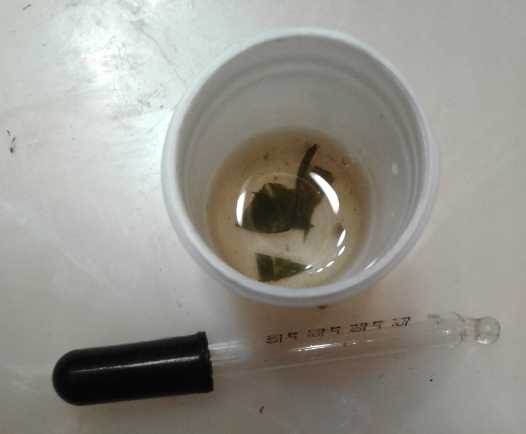 By about the 20th I cut a little off the tip of a leaf and
put it in a couple of drops of water in a small ointment jar. I dripped
a drop of this into my right eye. After using the second drop the next
day (with no notable ill effects), I cut a bit bigger piece and added
10(?) cc of water with the eyedropper. Then I munched up the pieces of
leaf (still only about maybe 10x10 mm worth of leaf tip) with the
flatish butt end of a spoon. The water acquired a bit of greenish
color. On the 22nd I dripped in a drop, then on the 24th. (Okay, I
forgot on the 23rd. I didn't take my vitamins, either.) I'll just do
one eye for now, a drop daily, until I see what, if anything, happens.
(Might it eliminate floaters... and maybe even cataracts?)
By about the 20th I cut a little off the tip of a leaf and
put it in a couple of drops of water in a small ointment jar. I dripped
a drop of this into my right eye. After using the second drop the next
day (with no notable ill effects), I cut a bit bigger piece and added
10(?) cc of water with the eyedropper. Then I munched up the pieces of
leaf (still only about maybe 10x10 mm worth of leaf tip) with the
flatish butt end of a spoon. The water acquired a bit of greenish
color. On the 22nd I dripped in a drop, then on the 24th. (Okay, I
forgot on the 23rd. I didn't take my vitamins, either.) I'll just do
one eye for now, a drop daily, until I see what, if anything, happens.
(Might it eliminate floaters... and maybe even cataracts?)
Why did I bother writing about this too soon to see any
notable results? Simply to record these starting dates and the
procedure while I remember them, if only for my own reference. I'll
report any discernible results or lack thereof in a few months.
Gardening &
Chickens
 The garden is
mostly finished except for a few fall and winter plants: chard and
brussels sprouts. Here's the only head
of chicory that looked any good. But it isn't like in the pictures, and
it tastes bitter. It probably took
too long to grow to taste good, and I don't think I'll try growing it
again.
The garden is
mostly finished except for a few fall and winter plants: chard and
brussels sprouts. Here's the only head
of chicory that looked any good. But it isn't like in the pictures, and
it tastes bitter. It probably took
too long to grow to taste good, and I don't think I'll try growing it
again.
Chickens
Apart from my hen and rooster in the "chickenmobile", I
seem to have acquired a flock of 13 chicks (rapidly becoming chickens),
two ducks and a turkey via my new renter -- who after just six weeks,
is moving to Vernon. They have savaged my new fenced garden plot, which
by the time they arrived didn't have much left in it but a few swiss
chard, and some potatoes, still buried. (I had just torn out the highly
productive peas. They did eat the new rhubarb plant. Rats! A hawk got 3
ducks and the mother hen before things were set up very well.)
It is mucky and smells like a barnyard, but they have
fertilized it and eaten the weeds, so it will be much easier to restart
the garden next spring. In fact, I think I'll expand it now and make it
larger. I left the excess fence wire rolled up at one end and only put
in a very few fence staples, so all I have to do is put in 3 more posts
and pull the wire around to enclose more lawn for them to devastate.
Ducks eat slugs, which should help with that major problem.
They still need proper coops, and I wonder how many
rooster dinners I will have to make in the coming months? I don't
actually want to keep - and have to feed - so many birds.
Small
Thots
* Freedom of Speech
is always under attack. Freedom of speech isn't about
being able to say generally agreeable things. Freedom of speech is
about you being allowed to express your real thoughts, opinions and
beliefs to others, to say whatever you truly believe, even if I think
it's stupid. Even when I think you're wrong. Even if it's "politically
incorrect". Even if I think you're full of baloney. Even when everybody
thinks you're full of baloney.
And sometimes, one person is right and everyone else is
wrong. For example false assumptions become embedded in the "group
psyche" even without conscious realization. The first person to
discover new facts or better analyze the subject and realize the actual
case, or discover a better solution or a better way of organizing
something, is immediately at odds with everyone else. Should we all
silence him - refuse to allow his web site to show up in searches,
remove his posts from Facebook and Twitter and his videos from Youtube?
He will remain at odds with everyone until they catch on. If we silence
him, all the rest of us can just naively stay wrong, most often to our
detriment.
And even if a person is wrong, at least we know him
better. It is always up to the listener's discernment to separate truth
from falsehood, whether the information is coming from an "orthodox" or
"authoritative" source or a lone voice in the wilderness, and it always
will be.
* Ice melt in Greenland and Antarctica has even more consequences to
sea level than I
realized. As the ice melts, these continents get lighter. I expect that
will cause them to rise higher out of the sea, which would cause other
regions to sink in compensation.
What I didn't think of is that as they get lighter, also
their gravitational pull is reduced. This in itself causes the water to
retreat away, or rather to be less pulled toward them. Thus these two
incontinent continents appear to be rising even without any
actual land rise, as the water level subsides away from their shores.
* Coronavirus Insanity
There is a very odd feature to the so-called "second wave"
of coronavirus. Basically it's virtually unreal. Governments are
working off of statistics of positive results in coronavirus tests,
which are so misleading as to be lies. Essentially the imperfect tests
give 2.5% false negative results and 2.5% false positive results. That
sounds almost trivial, but those false positives are being considered
to be
"coronavirus cases", and unlike last spring when the epidemic was in
full swing, they are now testing tens of millions of people - whole
populations. The more tests, the more "cases". If one tests 40 million
people, that gives 1 million "coronavirus cases" readings even if no
one actually has the virus. So one gets a graph like this:

A much more realistic graph is one of hospitalizations or
deaths from coronavirus, such as this sample of the same times and
places as above:
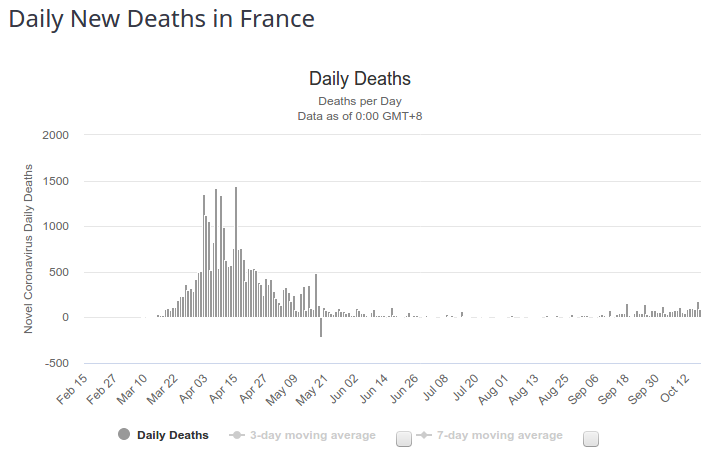
So one can see that the idea of "locking down" to "spread
out the curve" and prevent hospitals from being overrun (which never
happened anywhere except perhaps Wuhan China, with of without
lockdowns) is absurd. Furthermore, the World Health Organization
("WHO") which suggested them in the first place has now itself said
that they are counterproductive. So on whose advice, authority or
expertise are further lockdowns anywhere being imposed or even
contemplated? And on what misleading evidence?
I have nothing against reasonable measures to help prevent
spread of this nasty disease, but the hysteria is causing damage to
society out of all proportion to the effects of the disease itself.
On the eve of a new government imposed lockdown in Paris -
flying in the face of all reasonableness and sanction by any medical
authority - highways out of the city for were jammed with traffic for
50 Km in every direction.
* Here is a link to the "Fire Tornados" story I read (last month's
issue,
#148) that detailed why forest fires in California have become so
devastating:
https://www.wired.com/story/west-coast-california-wildfire-infernos/?utm_source=pocket-newtab
* This chart shows how each generation since World War Two has been
poorer than the previous as the population relentlessly expands and
wealth is further and further - and more and more unequally - spread.
Whereas "baby boomers" had almost 1/3 of national "household wealth"
when they were of the age to raise families, "millennials" today have
all of 3%. Most can never hope to own their own home - let alone
without a mortgage burden.
Prosperity will not be had again by most until the world's
population is drasticly reduced, perhaps to around 3 billion. (It was
2-3/4 billion when I was born in 1955. (By the time I was working in
the city in 1977, it was 4 billion and house prices were going up
faster than even a good "career" job earned money. Whatever it did to
the course of my life at such a young age, I did well financially to
buy
one then, pretty much "ASAP". Within a very few years it got much
harder.)

ESD
(Eccentric Silliness Department)
* A bit of Humor can ruin a perfectly good depression.
* USA used to be the industrial hub of the world. Today most everything
they
have is made overseas. GM, Standard Oil and the other co-conspiritors
destroyed the electric rail transport
infrastructure in the first half of the 20th century, and now the roads
and bridges are falling apart. A huge gap in wealth equality has
developed, zillions of farmers have been bankrupted and soon people
will be starving in the streets. USA is an
"undeveloping" nation.
* A take on the world's horrible plastic pollution situation (by J.
Nguyen).
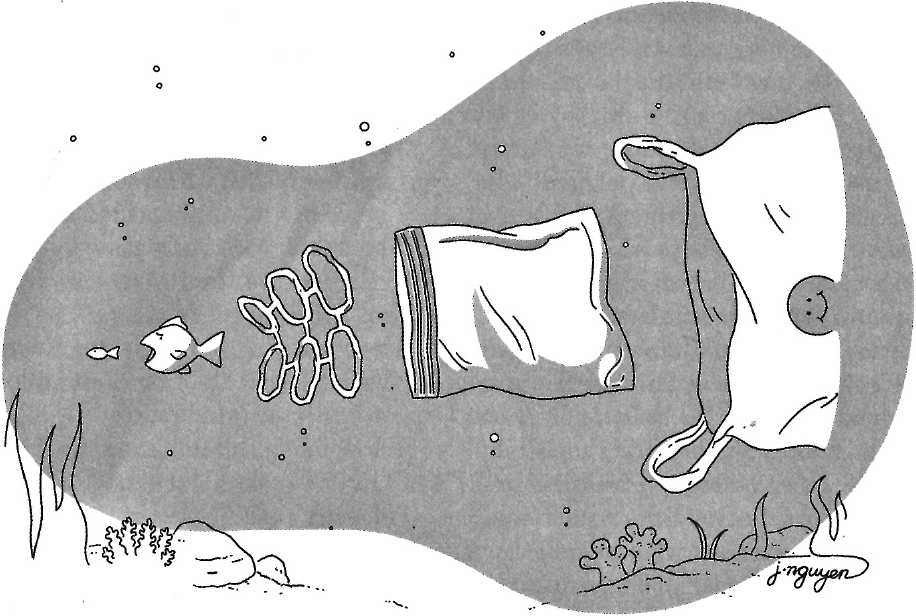
* An anonymous(?) take on capitalism - especially as it has been
practiced
in this century so far. More and more brazenly it's been outright
looting and pillaging of the populace with less and less actual
production or service to them. The "middle class" is virtually
gone in the USA, its wealth stealthily sucked away by the 1% of the 1%.
Nobel prize winning economist Noam Chomsky says capitalism is
incompatible with democracy. (Watch on youtube.) We need to develop new
ways of managing our economies.

* In world war one armored fighting vehicles (which started in Belgium
with armored cars as a fighting innovation while the Germans were
invading) were secretly developed in
Britain. In order to keep them secret, the military code-named them
"tanks". Surely people would think of water cisterns and suchlike. What
an impenetrable disguise: No one would ever think a "tank" might be a
weapon of war! But it's probably time to switch to a new code name - I
think people are catching on!
* World War One has proven to have had a 100% fatality rate. Every
person who fought in it has died. (Probably years ago. I remember a
Remembrance Day, on TV some years ago, wherein just 3 veterans took
part, who
were all over 100.)
* Since I'm somehow on the subject and subscribers will be reading this
in early November, here's a little Remembrance Day story, completely
irrelevant to anything, but few outside our family have heard it and I
venture to put it down here. My
Mom's Dad, Norman Wardlaw, had an eventful military career. I heard it
from her. Either the versions have changed slightly over the years
(suggesting my Mom's memory isn't perfect) or my memory isn't perfect.
(Human memory including mine is well known to be quite treacherous as
to details.) And well, after all, some the stories are from over 100
years ago now. I phoned my mom for details and she dug out something
written down. What I managed to scribble down as she talked filled in
some gaps, but it didn't all jibe 100% with what I remember hearing
from many years earlier. So this is as
close as I can get.
In World War I he was in the famous battle of Vimy Ridge
(2nd leftenant),
where he was shot in the ankle. He found a wounded horse and rode it
back to the Canadian lines. He lay outside the aid station all night
while men with worse wounds were being treated, and the doctors
comandeered his bottle of rye several times for other patients. The
doctor said he would never walk (or
at least, march) again and discharged him from the army. He recovered,
but in the press of war shipping he was unable to get a ship back to
Canada. (Remember, no one had ever flown across the Atlantic
Ocean! Hmm... The notes said he had wanted to stay - nothing to do with
shipping.)
(Canadian corps commander general Arthur Currie was
ordered to take the Vimy Ridge. When he explained his elaborate and
well prepared attack plan to the British and French command, they broke
up laughing at it. But when the ridge was taken, and without a huge
slaughter of Canadian troops, it became a model for future assaults.
After the war political enemies accused Currie of leading a charge on
November 10th 1918, a day before all hostilities were to cease, and
getting a bunch of men killed. This was a gross distortion of a
cautious
advance into Mons through essentially unoccupied territory (per orders
from higher up), but everybody believed it and Currie's reputation was
for a time badly damaged. He sued the newspaper that printed the story
and won. But I digress.)
DH.9A Bomber designed by
Geoffery de
Haviland,
who later created the untouchable WW2 Mosquito
fighter-bomber, and still later the world's first
pressurized cabin jet airliner, the infamous Comet.
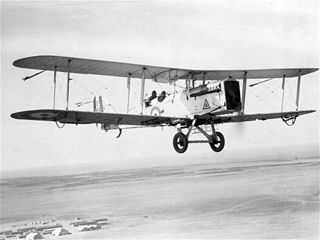 On 1st November 1917 Norm joined the newly forming "Hyderabad" 110
Squadron of the "Independent Air Force", created with planes
purchased/funded
by the Nizam of Hyderabad and based in Gloucester, UK, becoming full
leftenant. (Nizam = English ruler of a principality in India)
This was effectively part of the Royal Flying Corps (which later became
the RAF, but at this time it was run by the army). After
learning to fly, in June 1918 he flew an Airco DH.9A bomber in the
world's first strategic bombing raids. The first expedition was all
shot down, and all but one of the second. (The engines of the DH.9A
performed poorly. They were replaced after these early disasters.) He
flew in the second raid and was shot down by the "Red Baron" von
Richthofen's "flying circus". His observer was killed. He
said there wasn't a piece of the plane that wasn't riddled with bullet
holes. He marveled that he himself could still be in one piece.
On 1st November 1917 Norm joined the newly forming "Hyderabad" 110
Squadron of the "Independent Air Force", created with planes
purchased/funded
by the Nizam of Hyderabad and based in Gloucester, UK, becoming full
leftenant. (Nizam = English ruler of a principality in India)
This was effectively part of the Royal Flying Corps (which later became
the RAF, but at this time it was run by the army). After
learning to fly, in June 1918 he flew an Airco DH.9A bomber in the
world's first strategic bombing raids. The first expedition was all
shot down, and all but one of the second. (The engines of the DH.9A
performed poorly. They were replaced after these early disasters.) He
flew in the second raid and was shot down by the "Red Baron" von
Richthofen's "flying circus". His observer was killed. He
said there wasn't a piece of the plane that wasn't riddled with bullet
holes. He marveled that he himself could still be in one piece.
In one version of the story as I recall it, he crashed in
no-man's land between the lines, and he lay without moving all day.
When it was dark he crawled back to the Allied lines. My mom's notes
now deny this, but if he didn't crash in no-man's land, where did he
crash? But I may just possibly have confused the sequence with Vimy
Ridge events. Anyway he was
reprimanded for coming back without the airplane. However the actual
event unfolded, he survived and
had a family, so I'm who I am.
He stayed in Europe into 1919, flying mail in Germany.
In civilian life he was a small town lawyer (Orangeville, Ontario - And
he would complain for years about his ankle.) My
Mom (b. 1925 - BTW we just celebrated her 95th birthday via "Zoom" with
a substantial and geographically diverse guest list including some
relatives I haven't seen for decades. But I digress again.) says in the
depression she asked him for money for candy. He turned
out his empty pants pockets - not a penny! (But they didn't go hungry.
And she said that in that hard time, in that small town if someone came
by and asked for work, people including her family would give them a
meal even if they had no work for them.)
In World War II Norm was back in Europe, in the supply
service. In Holland
he and a Polish man drove on ahead to try to arrange billets for
the men. They came across a German sargent with another man and tried
to talk them into surrendering. But they had gone too far - into German
held territory. A German
General and a Canadian General came along in another jeep. They were
effecting a 24 hour truce to evacuate the civilians from the Scheldt
estuary area before the battle. (...for which the Dutch were lastingly
grateful, but it cost many Canadian casualties and delayed clearing the
badly needed Scheldt ports for allied shipping. IIRC the main port
city, Antwerp, had been taken but the Germans still had heavy guns to
shell any ship that dared enter the estuary approaches to it. The
Germans used the pause to pack in many reinforcements. But again I
digress.)
The German general said "Those men aren't supposed to be here!
Get them!" The Canadian general said he saw their jeep disappear in a
hail of bullets. At mess that evening he said "I sure didn't expect to
see you guys again!" (I can't help but wonder that these Germans
probably didn't really have their hearts in the job of killing men they
had just been talking with... during a truce... with a Canadian general
watching.) By the end of the war Norm was a leftenant colonel. He said
he was born to be hanged, since the enemy couldn't kill him.
In the 1960s he became a "snowbird" who spent winters in
Florida, a
popular thing for Canadians to do in that time period. He flew to the
west coast and
visited us in Fanny Bay, BC in 1973 - my best memory of this
happy-tempered man, when I
was 18. He died in 1980, age 85. (not hanged.)
"in depth reports" for
each project are below. I hope they may be useful to anyone who wants
to get into a similar project, to glean ideas for how something
might be done, as well as things that might have been tried, or just
thought
of and not tried... and even of how not to do something - why
it didn't
work or proved impractical. Sometimes they set out inventive thoughts
almost as they occur - and are the actual organization and elaboration
in writing of those thoughts. They are thus partly a diary and are not
extensively proof-read for literary perfection, consistency,
completeness and elimination of duplications before
publication. I hope they add to the body of wisdom for other
researchers and developers to help them find more productive paths and
avoid potential pitfalls and dead ends.
Ground
Effect
Vehicle
(1/4
scale
model)
(28th) Well, the circuit below was made and then found to be not the
right thing at all. It seems radio controlled model aircraft controls
operate by an odd form of PWM rather than linear voltages. At least I
didn't
spend a lot of time on it. I can re-use the cables I made up.
(19th) In spite of various demands on my time, I finally took a day to
do the circuit and circuit board for the ducted fans controls, throttle
plus steering and so they would shut off (instead of rev up!!!) if
contact with the transmitter was lost.
It was a bit of a brain teaser, but I think I finally got
it configured right with four OpAmps (two dual CA3260 single 5 volt
OpAmp chips with rail to rail outputs). Since they couldn't handle
input swings to the "+" rail, I divided the inputs by 2 with resistors
to ground, 0 to 2.5 volts for throttle and the same for steering. OpAmp
gain being 1+(Rf/Ri) two equal resistors changed it back to 0 to 5
volts... except it was inverted, 5 volts (stop) to 0 volts (full power)
for the backward throttle controls on the motors.
A half way resistive voltage reference (1.25 volts) set
threshold points for the steering: if the control went anywhere from
the center to the left (to turn left), the right side would remain at 0
volts and only the throttle would determine its power. The left side
would go from 0 volts up to 2.5 volts at the end of the stick's travel,
at which point even at full throttle (2.5V) the left side ducted fan
would stop. Vice versa for turning to the right.
That should be good enough.
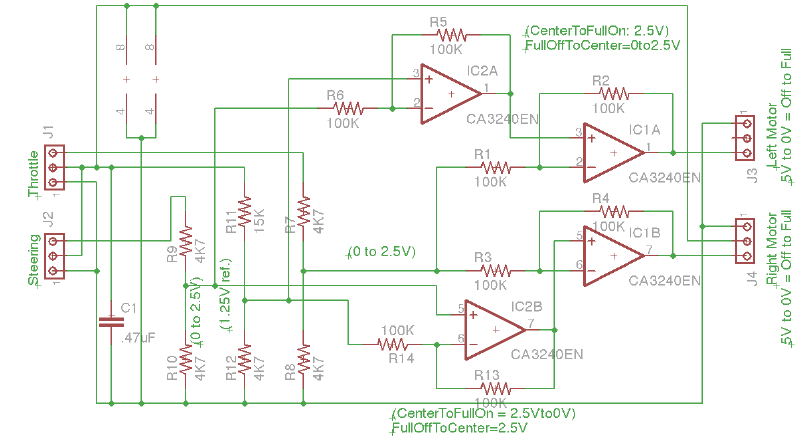
Then I layed out the board as a single sided board. That
went surprisingly smoothly with just one jumper. I exported it to
".PNG" at 600 DPI, then I edited it in Graphic Converter, enlarging the
size of the each component pad with "circle" and "paint", since they
were really sized for multi layer boards with through hole plating. I
know it's easier to get good results with a coarse board with wide
traces and large pads - or at least, poorer results are more likely to
be "good enough".
Somewhere in there I remembered there was such a thing as
"toner transfer paper" from "Fab in a Box" to transfer the design onto
the copper board,
and eventually that one runs the board through a hot laminator about a
dozen times to melt the toner and stick it to the copper. Then the glue
holding the toner to the transfer paper dissolves in seconds in water,
leaving the paper floating loose and the design on the copper. (How
long
since I've made a circuit board, again?)
I couldn't find the paper, but
I found a spare package I had put away for when the first one ran out.
I gave up and
opened the spare. The print came out well.
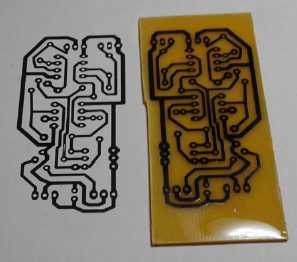 In the evening I got back to it. It transferred to the
copper well. The board etched in maybe 6-7 minutes. I drilled the
holes, then wiped off the toner with methylene chloride, which very
small
bottle I spilled. Then I wetted it with liquid tin and it turned silver
color. Ready for parts! (All in all, a pretty smooth operation. Did
that mean I had designed the whole circuit wrong? [This premonition
proved to be true.])
In the evening I got back to it. It transferred to the
copper well. The board etched in maybe 6-7 minutes. I drilled the
holes, then wiped off the toner with methylene chloride, which very
small
bottle I spilled. Then I wetted it with liquid tin and it turned silver
color. Ready for parts! (All in all, a pretty smooth operation. Did
that mean I had designed the whole circuit wrong? [This premonition
proved to be true.])
Then I drilled the holes with a dremmel type tool and
soldered on most of the parts, except for cables and the OpAmps, which
I didn't seem to have.
(28th) The OpAmps arrived on the 27th and I set about completing the
circuit board. That done, I ran into a snag. It didn't work, so I
started getting more into it. I made a cable "breakout" so I could
check voltages and found an unwelcome aspect to the operation.
I've never found much
information on the radio control
receivers. No manual came with my equipment (in spite of buying
everything from
a local hobby shop in Victoria BC trying to avoid the usual Chinese
lack of manuals and information. There was nothing anyway.) But when
the receiver runs off of +5 volts, I assumed that it contains digital
logic, and that logically the control signals would vary from 0 to 5
volts, full off to full on.
That was a mistake - I should have searched on line until
I found factual answers. They each seemed to go from around .1 volts to
.36 - and not even to be very stable within that range. One only went
to about .27V. Why would one choose such miniscale voltages that they
might be subject to electrical noise when there was 5 volts to play
with? It didn't seem to make much sense. And of course it threw my
entire circuit with all my calculations way off.
So I finally got to that web search. Apparently it's even
more complex: every part has pretty sophisticated electronics, and it's
all done with pulse width modulation. The low voltages were merely
narrow digital pulses. Somehow I never suspected it would be done that
way - surely servomechanisms would be controlled by a simple analog
voltage? The actual frequency is around 44 to 50 Hz, but only the ON
pulse width counts (with slightly different figures for OFF and ON
depending who you read and depending on manufacturer): approximately .5
or .8 or 1.0 mSec or less is supposed to be completely OFF (or for a
servo, to one end of its travel), 1.5 mSec is half way, and 2.0 or 2.5
or 3.0 mSec or more is full ON, or the other end of the servo's travel.
So I'll have to toss out the opamps and make a
microcontroller based circuit. I have the programming system, and I
have an MSP board design done up. But maybe I'll just use a TI
"Launchpad"
board as-is. It's not like I want to mass-produce them.
So: the inputs and outputs are just digital logic PWM. All
I have to do is program it, and connect everything. (Hmm, do I have to
step down the 6 volts to 5 V or 3.3 V? Well, maybe I'll just put in two
diodes to drop the 6V down to 4.8 to be on the safe side.) So the
circuitry comes down to two diodes and four connection cables between
the board, the receiver inputs and the "ESC" motor controller outputs.
The rest is programming. Ugh, here I thought I was done, or virtually
done, and instead I've hardly started!
Mia culpa for not checking the mechanisms of radio controlled model
aircraft in advance. But I have excuses... I haven't been interested in
model aircraft since I was about 13, and back then it was double
control lines for the elevator and they just flew in circles around you
until the fuel ran out, making lots of noise. And of course, originally
I was not expecting to have to modify the controls, just to plug in
pre-made parts. The need for modifying things just crept up on me. When
I realized I could do the steering via left and right ducted fans, it
didn't occur to me that there was no R/C control transmitter available
that provides for independent operation of twin or more
motors/propellers. At first I thought to use two channels and operate
the joystick diagonally to keep it simple. But it still mystifies me
why it is arranged that the motors go to full power if the radio
control signal is lost, instead of shutting off. I absolutely don't
want that in case it happens. I couldn't find any information about it
on line.
(And additionally even once all that is cludjed together,
there's still no way to run the fans in reverse for maneuvering up to a
wharf, either: "ESC" aircraft motor controllers simply have no
"forward/reverse" control! So that would require reversing two of the
high power phases to each motor rather than just the control wiring...
and figuring out how to further modify the joystick controls to operate
that appropriately. I'll just have to leave "reverse" capability out of
the model and run it up on shore to end each voyage. The choice for
adding functions would probably be to have two control transmitters,
and two receivers on the model.)
More on radio control models:
https://www.mitchr.me/SS/batteriesRequired/RCcontrolTheory/index.html
Other
"Green" Electric Equipment Projects
"MINI
T-Plug"
12VDC
--> Now Replacing CAT 12VDC <--
"Mini T-Plug" Connectors
The tiny connectors arrived around the start of the month.
I was slightly dubious, but they mated together very firmly. Unless the
gold plating wore off and they became quite corroded, they could
doubtless handle the 10 amps they were rated for. It seemed to me they
were a "go" for use as general purpose 12 volt connectors.
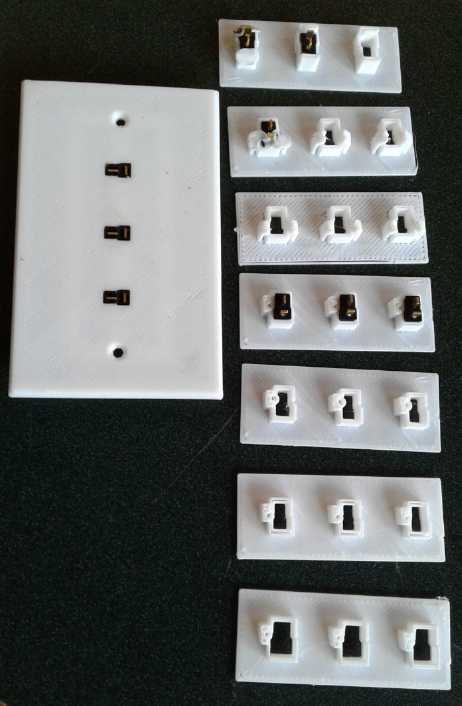 [12th] So I
started to redesign my wall plates for these very small
sockets. Again I made them triplex. Many more could have fit on the
standard size wall plate, but each socket has to be soldered to connect
it.
[12th] So I
started to redesign my wall plates for these very small
sockets. Again I made them triplex. Many more could have fit on the
standard size wall plate, but each socket has to be soldered to connect
it.
I was sure my first design would need tweaking and I came
up with the idea to save time and printer filament by only printing the
actual sockets on a small plate. This worked out well, and saved a lot
of time as it was "Take 8" before I had something that worked well and
I was satisfied with.
The main reason was that the plugs were so tiny. They had
a ridge at the back so they couldn't slide out the front of the plate,
but keeping them from sliding out the back the way they went in proved
tricky.
At first I tried to use the same idea as I had done for
the regular size plugs: put in a screw so that the head overlapped the
edge of the socket and held it in. I had some pretty tiny screws, but
none short enough for these low profile sockets.
Then I thought of making side supports to click them into
place. That proved to be not easily done via 3D printing. They popped
out too easily when a plug was inserted. The next idea was glue. But
not much glues to nylon (nor to PLA, apparently) and what I tried was
unsuccessful. (MEK - I already knew methylene chloride wouldn't work)
Finally I thought that since a soldering iron was needed
to solder the wires to the sockets anyway, I could put some extra PLA
plastic along a couple of edges and melt it over the back of the socket
with the soldering iron. This seemed to work quite well.
[13th] I took side cutters and chipped away the melted PLA on the test
plates. The nylon seemed to resist the heat well, as one of the sockets
had only a small blemish in one corner and I couldn't even identify the
other amongst several new ones.
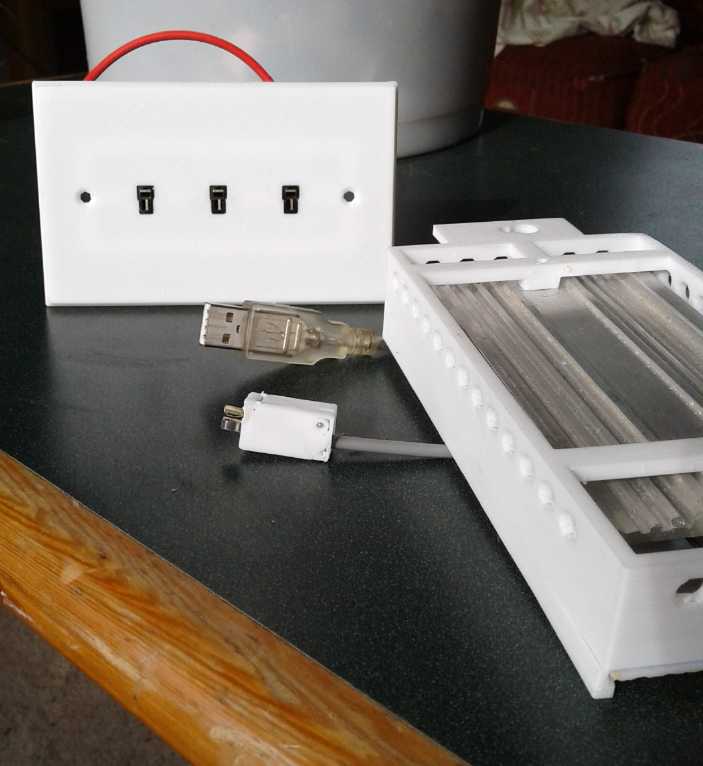 Then I decided
to go at the plug shells to enclose
appliance wires. The second try wasn't bad and I put it on my new LED
COB light. It's actually smaller than a USB computer plug.
Then I decided
to go at the plug shells to enclose
appliance wires. The second try wasn't bad and I put it on my new LED
COB light. It's actually smaller than a USB computer plug.
I'll probably want to tweak the design some more, but
these two items are the essentials for 12 volt off-grid wiring: plugs
for appliances
and sockets in a wall plate. When I can catch a break, I'll probably
advertise locally.
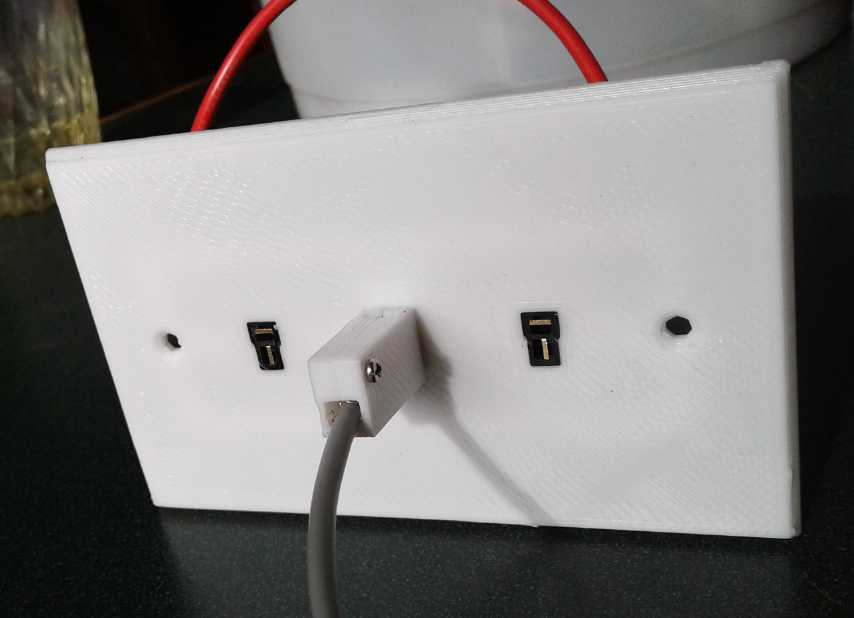
Let's see:
Minimalist Off-Grid Solar System
* 100 watt solar panel
* battery (options: from no additional cost for small used one, up)
* Panel with
- 12V lead-acid (PWM) charge controller
- Two circuit breakers
- Triplex 12V outlet plate
* Plug-in, mountable, 12V LED light
* Wire per requirements (from no extra cost for short lengths, up)
$190 ?
An aggravation is that I ordered eight LED "pot" lights
that said "12 Volts" on the web page expecting to be able to use them
for this, but they turned out to run only off line voltage adapters.
Inside they had about two dozen LED emitters in series on a strip,
indicating that they needed about 70+ volts DC to light them up. (Up to
30 volts from a lab power supply did nothing.)
Somebody bought some solar panels and components, but he
didn't go for a wall plate and plugs. Hmm. Maybe if I put together
some actual lights and the 'demo' setup I've been meaning to do for so
long, so that people can see it in use?
Windplant
I neglected to mention last month that there was a strong wind that
killed my MPT7210 charge controller. I had turned the wind system off.
I turned it on with the plant spinning away and saw a voltage reading
in the 70 volt range just before there was a poof with a flash and the
controller quit.
It's only rated for 50 or 60 volts. It would soon have dropped the
voltage and slowed the propeller if it had survived.
Perhaps I should put in the windplant's original 24 volt
controller and then use an MPT7210 to up it to ~39 volts to charge my
system. In fact, now that I think about it, it seems like an obvious
solution. Unless it's PWM with higher voltage spikes. I guess I should
check it on the oscilloscope.
And I should get a "dump load" to carry off excess when
there's more power than needed. That, properly encircuited, would have
saved the controller too. And maybe a couple more to sell.
Someone was asking about a solar electric heater... That would work,
even if it wouldn't keep a place warm. (I liked the solar-electric
water heater, but if the water is hot, one still needs another dump
load.) I ordered some 100 watt resistors off AliExpress to use as dump
loads and mounted the windplant's charge controller. But I didn't get
as far as wiring it or testing it. We've had lots of wind - I should
get onto it so I can check it while it's blowing.
My Solar Power System
Month of October Log of Solar
Power Generated [and grid power consumed]
(All times are in PST: clock 48 minutes ahead of sun, not PDT which is
an
hour and 48 minutes ahead. DC power output readings - mostly the
kitchen hot
water heater for some months, then just lights - are reset to zero
daily (for just lights, occasionally), while the others are
cumulative.)
Solar: House, Trailer => total KWH [grid power meter
reading(s)@time] Sky conditions
Km = electric car drove distance, then car was charged.
September
30th 1039.13,254.06 => 1.72 [55Km; 76685@22:00] Cloudy,
drizzle.
October
01th 1041.68,255.46 => 3.95 [76707@19:00] Just cloudy.
02d 1044.39,257.38 => 4.63 [85Km; 76737@21:00] Some sun
(yay!) and some mist.
03rd 1047.36,258.87 => 4.46 [35Km; 76752@22:30] Clouds,
then mostly sunny PM.
04th 1050.03,260.62 => 4.42 [76787@22:00] Some sun
again. Rain toward evening.
05th 1052.62,262.26 => 4.23 [55Km; 76810@18:00] Some rain,
some clouds, a bit of sun.
06th 1055.47,264.01 => 4.58 [76830@21:00] Similar again.
07th 1057.13,264.87 => 2.52 [76863@19:00] Pretty dark
but little rain.
08th 1060.64,266.90 => 5.54 [76898@20:30] Some actual
sunshine, but obscurred by jet trails.
09th 1061.68,267.47 => 1.61 [55Km; 76937@18:00] Oh sure:
rain and wind all day, then sun came out a bit too late to help solar.
(55Km driving was on 7th but forgot to plug car in.)
10th 1065.02,269.57 => 5.44 [55Km; 76977@18:30] Some sun but
rain midday.
11th 1069.24,272.25 => 6.90 [35Km; 77022@18:00] Mostly
bright sunshine, but a couple of dark deluges.
12th 1072.29,274.57 => 5.37 [77050@18:30] Sunshine. Some
cloudy periods.
13th 1074.83,276.14 => 4.11 [77097@17:00; 55Km] More
clouds than sun.
14th 1078.21,277.95 => 5.19 [55Km; 77158@18:30] Not a
lot of sun - must have been lighter clouds.
15th 1078.64,278.11 => 0.49 [77210@18:00] Wind and rain
- pretty dark. not nice out.
16th 1081.55,279.90 => 4.70 [85Km; 77267@18:00] Mostly
fairly sunny?
17th 1082.28,280.27 => 1.10 [55Km+35Km; 77323@17:00]
Mostly rain.
18th 1083.41,280.91 => 1.77 [77371@19:00] Very light
drizzle all day.
19th 1086.04,282.63 => 4.35 [77412@18:30] Mostly sunny.
20th 1088.52,284.17 => 4.02 [77454@18:30] Mix of sun and
rain.
21th 1090.98,285.77 => 4.06 [77501@17:30] see yesterday.
^
22th 1091.63,286.07 => 0.95 [77559@18:00] clouds and
rain.
23th 1094,34,287.85 => 4.49 [90Km; 77616@19:00] mostly
sunny.
24th 1097.75,290.39 => 5.95 [60Km; 77677@22:00] Sunny
day! (but cold - around freezing)
25th 1098.44,290.72 => 1.02 [77733@21:30] Cold. Rain. (Frost
gone, but not much warmer.)
26th 1101.98,292.48 => 5.30 [77768@18:00] Sunny and warm
most of the day! Clouds later.
27th 1102.16,292.80 => 0.50 [70Km; 77807@17:00] Heavy
overcast, rain
28th 1103.06,293.27 => 1.37 [77867@19:00] Cloudy, drizzle
29th 1103.41,293.43 => 0.51 [60Km; 77925@17:00] Rain.
30th 1105.40,295.09 => 3.65 [85Km; 77986@18:00] Sunny
with heavy jet trails.
31th 1106.41,295.61 => 1.53 [55Km; 78045@18:30] Rain.
November
01st 1107.24, 296.19 => 1.41 [78086@19:00] Morrain.
02st 1109.29, 297.23 => 3.09 [55Km; 78138@18:30] Sun and rain.
(even both at once)
Daily KWH from solar panels. (Compare October 2020 with September
2020 & with October 2019.)
KWH
(Each Day)
|
September 2020 (12 panels)
|
October 2020 (12 panels)
|
Oct. 2019 (12 Panels)
|
0.xx
|
1
|
4
|
2
|
1.xx
|
2
|
6
|
5
|
2.xx
|
3
|
1
|
5
|
3.xx
|
6
|
2
|
5
|
4.xx
|
2
|
11
|
3
|
5.xx
|
5
|
6
|
6
|
6.xx
|
2
|
1
|
2
|
7.xx
|
1
|
-
|
-
|
8.xx
|
-
|
-
|
3
|
9.xx
|
2
|
-
|
|
10.xx
|
1
|
-
|
|
11.xx
|
5
|
-
|
|
12.xx
|
-
|
-
|
|
13.xx
|
-
|
-
|
|
14.xx
|
-
|
-
|
|
15.xx
|
-
|
-
|
|
16.xx
|
-
|
-
|
|
17.xx
|
|
|
|
18.xx
|
|
|
|
Total KWH
|
175.77
|
109.83
|
120.52
|
Monthly Tallies: Solar Generated KWH [Power used from grid KWH]
2019
March 1-31: 116.19 + ------ + 105.93 = 222.12 KWH - solar [786 KWH -
used from
grid]
April - 1-30: 136.87 + ------ + 121.97 = 258.84 KWH [608 KWH]
May - 1-31: 156.23 + ------ + 147.47 = 303.70 KWH [543 KWH] (11th
solar panel connected on lawn on 26th)
June - 1-30: 146.63 + 15.65 + 115.26 = 277.54 KWH [374 KWH] (36V, 250W
Hot Water Heater installed on 7th)
July - 1-31: 134.06 + 19.06 + 120.86 = 273.98 KWH [342 KWH]
August 1-31:127.47 + 11.44+91.82+(8/10)*96.29 = 307.76 KWH [334 KWH]
(12th panel connected on lawn Aug. 1)
Sept.- 1-30: 110.72 + 15.30 + 84.91 = 210.93 KWH [408 KWH]
(solar includes 2/10 of 96.29)
Oct. - 1-31: 55.67 + 13.03 + 51.82 = 120.52 KWH, solar
[635 KWH - from grid]
Nov. - 1-30: 36.51 + 6.31 + 26.29 = 69.11
KWH, solar [653 KWH - from grid]
Dec. - 1-23: 18.98 + .84* + 11.70 =
31.52
KWH, solar + wind [711 KWH + 414 (while away) = 1125 from grid]
2020
Jan. - 6-31: 17.52 + ------* + 10.61 = 28.13 KWH,
solar+
wind [1111 KWH from grid]
Feb. - 1-29: 56.83 + ------* + 35.17 = 92.00 KWH,
solar + wind [963 KWH from grid]
* Now the solar DC system is only running a couple of
lights - not worth reporting. So there's just the 2 grid tie systems:
house and "roof over travel trailer".
One year of solar!
March - 1-31: 111.31 + 87.05 = 198.37 KWH solar total
[934 KWH from grid]
April - 1-30: 156.09 + 115.12 = 271.21 [784 KWH
from grid]
May - 1-31: 181.97 + 131.21 = 313.18 KWH
Solar [723 KWH from grid]
June - 1-30: 164.04 + 119.81 = 283.82 KWH Solar [455 KWH
from grid]
July - 1-31: 190.13 + 110.05 = 300.18 KWH Solar [340
KWH from grid]
August- 1-31: 121.81 + 83.62 = 205.43 KWH Solar [385KWH
from Grid]
Sept. - 1-30: 110.68 + 65.09 = 175.77 KWH Solar [564
KWH used from grid]
Oct. - 1-31: 67.28 + 42.55 = 109.83
KWH Solar [1360 KWH from grid -- Renters!]
Things Noted - October 2020
* As the sun gets lower, the solar output has dropped
disproportionately. It would be really nice to raise the solar
panels up to a higher angle than the ~15 degree roof slope on both
buildings. Even to 25° would probably be a considerable
improvement. To somewhere between 30 and 45° would probably be
optimum - an
improvement for about nine months of the year. 30° would be best at
summer solstice, but 45° only a 13% drop then, with
more improvement the other 9 or 10 months of the year.
Of course, there's less to be had in winter regardless,
but December and January figures might be almost double what they are
with better aim. (Two times almost nothing is... whoopee!)
* I think I was too worried about powerful winds when I mounted the
panels flat onto the roofs (rooves?). If I could find time to add some
more panels or remount the ones I have to steeper angles, I could be
getting in winter, if not a lot of power, at least substantially more
than I get now. A 50% increase when there's so little would be a big
help keeping lights and freezer/fridge running if the grid ever goes
down for days or longer.
* On the 26th I noticed the house was making over 1100 watts and the
trailer roof 690 in the middle of the day. That would be good energy if
it wasn't such a short time that all the tree shadows are off the
collectors. Maybe changing the collector angles wouldn't be the big
improvement I've been thinking. (OTOH the panels propped up on the lawn
are at pretty good angles already, which was surely helping
considerably.)
* To judge by the last 3 months the weather has been cloudier this fall
than last. Basicly the KWH figures suck for later in 2020. (May to July
look better than 2019, but an 11th solar panel was added for June 2019
and a 12th for August 2019. Since then it has mostly been 12 panels.)
Electricity
Storage
(Batteries)
Turquoise
Battery
Project:
Long
lasting, low cost, high energy batteries
Wow... With everything ready to make what should be the
best cell so far... yet again... Sorry, no report!
http://www.TurquoiseEnergy.com
Haida Gwaii, BC Canada

 By about the 20th I cut a little off the tip of a leaf and
put it in a couple of drops of water in a small ointment jar. I dripped
a drop of this into my right eye. After using the second drop the next
day (with no notable ill effects), I cut a bit bigger piece and added
10(?) cc of water with the eyedropper. Then I munched up the pieces of
leaf (still only about maybe 10x10 mm worth of leaf tip) with the
flatish butt end of a spoon. The water acquired a bit of greenish
color. On the 22nd I dripped in a drop, then on the 24th. (Okay, I
forgot on the 23rd. I didn't take my vitamins, either.) I'll just do
one eye for now, a drop daily, until I see what, if anything, happens.
(Might it eliminate floaters... and maybe even cataracts?)
By about the 20th I cut a little off the tip of a leaf and
put it in a couple of drops of water in a small ointment jar. I dripped
a drop of this into my right eye. After using the second drop the next
day (with no notable ill effects), I cut a bit bigger piece and added
10(?) cc of water with the eyedropper. Then I munched up the pieces of
leaf (still only about maybe 10x10 mm worth of leaf tip) with the
flatish butt end of a spoon. The water acquired a bit of greenish
color. On the 22nd I dripped in a drop, then on the 24th. (Okay, I
forgot on the 23rd. I didn't take my vitamins, either.) I'll just do
one eye for now, a drop daily, until I see what, if anything, happens.
(Might it eliminate floaters... and maybe even cataracts?) The garden is
mostly finished except for a few fall and winter plants: chard and
brussels sprouts. Here's the only head
of chicory that looked any good. But it isn't like in the pictures, and
it tastes bitter. It probably took
too long to grow to taste good, and I don't think I'll try growing it
again.
The garden is
mostly finished except for a few fall and winter plants: chard and
brussels sprouts. Here's the only head
of chicory that looked any good. But it isn't like in the pictures, and
it tastes bitter. It probably took
too long to grow to taste good, and I don't think I'll try growing it
again.




 On 1st November 1917 Norm joined the newly forming "Hyderabad" 110
Squadron of the "Independent Air Force", created with planes
purchased/funded
by the Nizam of Hyderabad and based in Gloucester, UK, becoming full
leftenant. (Nizam = English ruler of a principality in India)
This was effectively part of the Royal Flying Corps (which later became
the RAF, but at this time it was run by the army). After
learning to fly, in June 1918 he flew an Airco DH.9A bomber in the
world's first strategic bombing raids. The first expedition was all
shot down, and all but one of the second. (The engines of the DH.9A
performed poorly. They were replaced after these early disasters.) He
flew in the second raid and was shot down by the "Red Baron" von
Richthofen's "flying circus". His observer was killed. He
said there wasn't a piece of the plane that wasn't riddled with bullet
holes. He marveled that he himself could still be in one piece.
On 1st November 1917 Norm joined the newly forming "Hyderabad" 110
Squadron of the "Independent Air Force", created with planes
purchased/funded
by the Nizam of Hyderabad and based in Gloucester, UK, becoming full
leftenant. (Nizam = English ruler of a principality in India)
This was effectively part of the Royal Flying Corps (which later became
the RAF, but at this time it was run by the army). After
learning to fly, in June 1918 he flew an Airco DH.9A bomber in the
world's first strategic bombing raids. The first expedition was all
shot down, and all but one of the second. (The engines of the DH.9A
performed poorly. They were replaced after these early disasters.) He
flew in the second raid and was shot down by the "Red Baron" von
Richthofen's "flying circus". His observer was killed. He
said there wasn't a piece of the plane that wasn't riddled with bullet
holes. He marveled that he himself could still be in one piece.
 In the evening I got back to it. It transferred to the
copper well. The board etched in maybe 6-7 minutes. I drilled the
holes, then wiped off the toner with methylene chloride, which very
small
bottle I spilled. Then I wetted it with liquid tin and it turned silver
color. Ready for parts! (All in all, a pretty smooth operation. Did
that mean I had designed the whole circuit wrong? [This premonition
proved to be true.])
In the evening I got back to it. It transferred to the
copper well. The board etched in maybe 6-7 minutes. I drilled the
holes, then wiped off the toner with methylene chloride, which very
small
bottle I spilled. Then I wetted it with liquid tin and it turned silver
color. Ready for parts! (All in all, a pretty smooth operation. Did
that mean I had designed the whole circuit wrong? [This premonition
proved to be true.]) [12th] So I
started to redesign my wall plates for these very small
sockets. Again I made them triplex. Many more could have fit on the
standard size wall plate, but each socket has to be soldered to connect
it.
[12th] So I
started to redesign my wall plates for these very small
sockets. Again I made them triplex. Many more could have fit on the
standard size wall plate, but each socket has to be soldered to connect
it. Then I decided
to go at the plug shells to enclose
appliance wires. The second try wasn't bad and I put it on my new LED
COB light. It's actually smaller than a USB computer plug.
Then I decided
to go at the plug shells to enclose
appliance wires. The second try wasn't bad and I put it on my new LED
COB light. It's actually smaller than a USB computer plug.